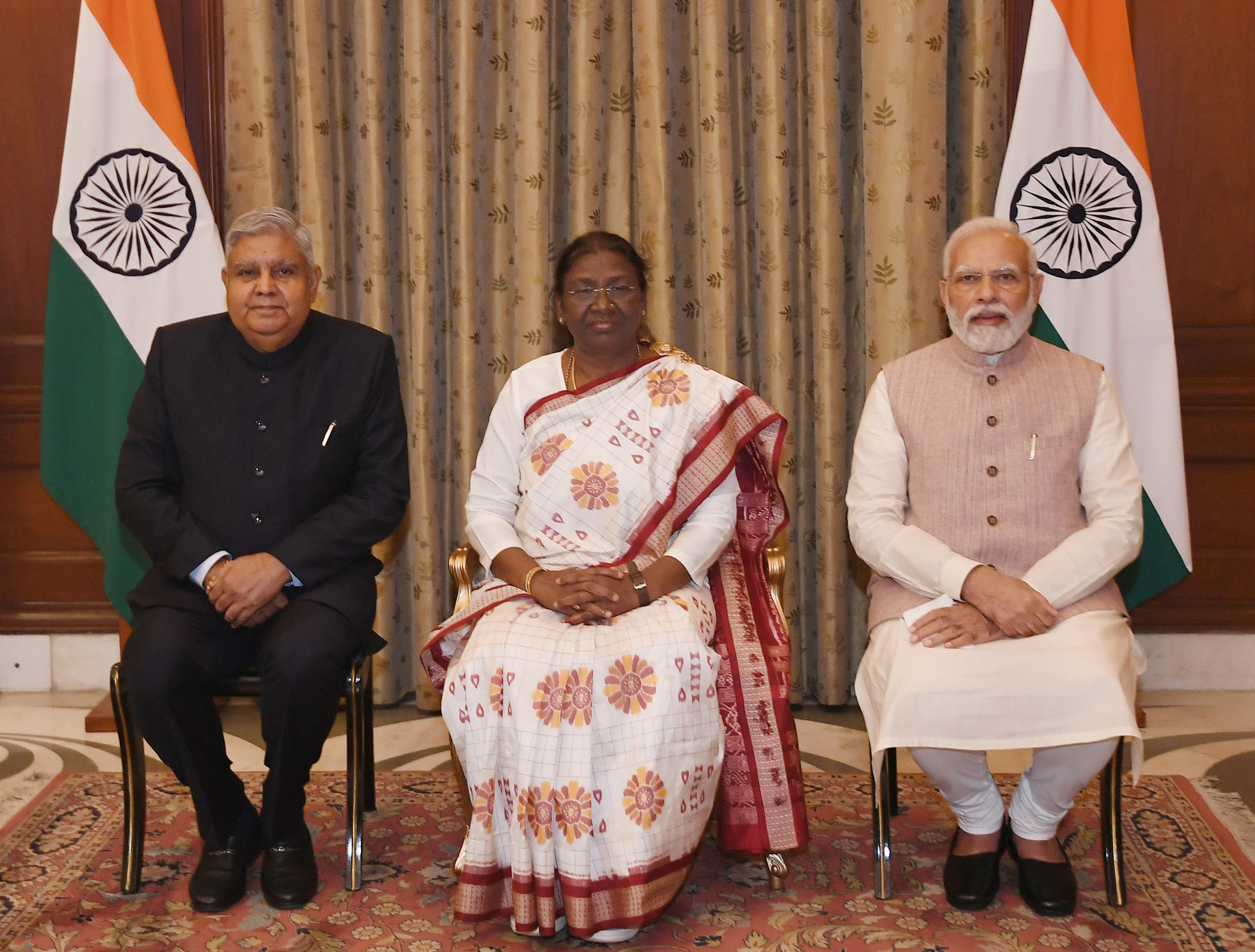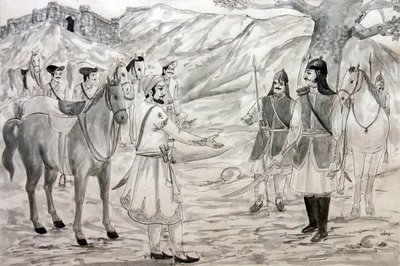|
Panna, Madhya Pradesh
Panna is a city and a municipality in Panna district in the Indian state of Madhya Pradesh. It is known for its diamond mines and temples. It is the administrative centre of Panna District. History Panna was a Bundela Rajput State. It was a Gond settlement until the 13th or 17th century (cite reference), when the Gondi were defeated by the Chandelas they migrated to other parts of Madhya Pradesh. Until that date, there were many rulers of the area. The famous mandir of Padmavatipuri Dham, adorned with divine lustre, is located in Panna town at the centre of Vindhyachal in Madhya Pradesh. The itinerant sage Mahamati Prannath and his disciples reached Panna with a divine message of awakening one's soul. Seeing a desert island, he decided to unfurl the flag of Jagani there. He helped the king Chhatrasal and adorned him with the title of Maharaja. He remained there for eleven years, and took samadhi inside the dome. The place, therefore, is known as the seat of salvation uktipit ... [...More Info...] [...Related Items...] OR: [Wikipedia] [Google] [Baidu] |
WikiProject Indian Cities
A WikiProject, or Wikiproject, is an affinity group for contributors with shared goals within the Wikimedia movement. WikiProjects are prevalent within the largest wiki, Wikipedia, and exist to varying degrees within Wikimedia project, sibling projects such as Wiktionary, Wikiquote, Wikidata, and Wikisource. They also exist in different languages, and translation of articles is a form of their collaboration. During the COVID-19 pandemic, CBS News noted the role of Wikipedia's WikiProject Medicine in maintaining the accuracy of articles related to the disease. Another WikiProject that has drawn attention is WikiProject Women Scientists, which was profiled by ''Smithsonian Magazine, Smithsonian'' for its efforts to improve coverage of women scientists which the profile noted had "helped increase the number of female scientists on Wikipedia from around 1,600 to over 5,000". On Wikipedia Some Wikipedia WikiProjects are substantial enough to engage in cooperative activities with outsi ... [...More Info...] [...Related Items...] OR: [Wikipedia] [Google] [Baidu] |
Rajput
Rājpūt (, from Sanskrit ''rājaputra'' meaning "son of a king"), also called Thākur (), is a large multi-component cluster of castes, kin bodies, and local groups, sharing social status and ideology of genealogical descent originating from the northern part of the Indian subcontinent. The term ''Rajput'' covers various patrilineal clans historically associated with warriorhood: several clans claim Rajput status, although not all claims are universally accepted. According to modern scholars, almost all Rajput clans originated from peasant or pastoral communities. Over time, the Rajputs emerged as a social class comprising people from a variety of ethnic and geographical backgrounds. From the 12th to 16th centuries, the membership of this class became largely hereditary, although new claims to Rajput status continued to be made in later centuries. Several Rajput-ruled kingdoms played a significant role in many regions of central and northern India from the seventh century ... [...More Info...] [...Related Items...] OR: [Wikipedia] [Google] [Baidu] |
Vindhya Pradesh
Vindhya Pradesh was a former state of India. It was created in 1948 as Union of Baghelkhand and Bundelkhand States from the territories of the princely states in the eastern portion of the former Central India Agency. It was named as Vindhya Pradesh on 25 January 1950 after the Vindhya Range, which runs through the centre of the province. The capital of the state was the former princely state of Rewa. It lay between Uttar Pradesh to the north and Madhya Pradesh to the south, and the enclave of Datia, which lay a short distance to the west, was surrounded by the state of Madhya Bharat. Vindhya Pradesh was merged into Madhya Pradesh in 1956, following the States Reorganisation Act. It occupied an area of 61,131.5 km2 (23,603 sq. miles). History Vindhya Pradesh state was formed on 12 March 1948 and inaugurated on 4 April 1948. 36 princely states were merged to form Vindhya Pradesh state: # Rewa # Panna # Datia # Orchha # Ajaigarh # Shahdol # Baraundha # Bijawar # ... [...More Info...] [...Related Items...] OR: [Wikipedia] [Google] [Baidu] |
Government Of India
The Government of India (ISO 15919, ISO: Bhārata Sarakāra, legally the Union Government or Union of India or the Central Government) is the national authority of the Republic of India, located in South Asia, consisting of States and union territories of India, 36 states and union territories. The government is led by the president of India (currently ) who largely exercises the executive powers, and selects the Prime Minister of India, prime minister of India and other ministers for aid and advice. Government has been formed by the The prime minister and their senior ministers belong to the Union Council of Ministers, its executive decision-making committee being the Cabinet (government), cabinet. The government, seated in New Delhi, has three primary branches: the legislature, the executive and the judiciary, whose powers are vested in bicameral Parliament of India, Union Council of Ministers (headed by prime minister), and the Supreme Court of India respectively, with a p ... [...More Info...] [...Related Items...] OR: [Wikipedia] [Google] [Baidu] |
Maharaja
Maharaja (also spelled Maharajah or Maharaj; ; feminine: Maharani) is a royal title in Indian subcontinent, Indian subcontinent of Sanskrit origin. In modern India and Medieval India, medieval northern India, the title was equivalent to a prince. However, in late ancient India and History of South India, medieval south India, the title denoted a king. The form "Maharaj" (without "-a") indicates a separation of noble and religious offices, although since in Marathi the suffix ''-a'' is silent, the two titles are near homophones. Historically, the title "Maharaja" has been used by kings since Vedic period, Vedic times and also in the second century by the Indo-Greek Kingdom, Indo-Greek rulers (such as the kings Apollodotus I and Menander I) and then later by the Indo-Scythians (such as the king Maues), and also the Kushans as a higher ranking variant of "Raja". Eventually, during the medieval era, the title "Maharaja" came to be used by sovereignty, sovereign princes and vassal ... [...More Info...] [...Related Items...] OR: [Wikipedia] [Google] [Baidu] |
Revolt Of 1857
The Indian Rebellion of 1857 was a major uprising in India in 1857–58 against the rule of the British East India Company, which functioned as a sovereign power on behalf of the British Crown. The rebellion began on 10 May 1857 in the form of a mutiny of sepoys of the company's army in the garrison town of Meerut, northeast of Delhi. It then erupted into other mutinies and civilian rebellions chiefly in the upper Gangetic plain and central India, though incidents of revolt also occurred farther north and east. The rebellion posed a military threat to British power in that region, and was contained only with the rebels' defeat in Gwalior on 20 June 1858., , and On 1 November 1858, the British granted amnesty to all rebels not involved in murder, though they did not declare the hostilities to have formally ended until 8 July 1859. The name of the revolt is contested, and it is variously described as the Sepoy Mutiny, the Indian Mutiny, the Great Rebellion, the Revolt of 1 ... [...More Info...] [...Related Items...] OR: [Wikipedia] [Google] [Baidu] |
Sohawal State
Sohawal State was a princely state of the Bagelkhand Agency of the British Raj. It was a relatively small Sanad state of about 552 km2 with a population of 32,216 inhabitants in 1901. Its capital was at Sohawal, a small town — 2,108 inhabitants in 1901 — located in modern Satna district of Madhya Pradesh. The state was divided in two sections separated by territory belonging to Kothi State and in its northern side it formed little enclaves within neighbouring Panna State. History Sohawal State was founded in the mid sixteenth century by a ruler named Fateh Singh. It had been originally much larger, but lost much territory within the first centuries of its existence. Sohawal became a British protectorate initially subordinate to Panna State, but a separate ''sanad'' was granted to ''Rais'' Aman Singh in 1809. During the 1830 – 1833 period there was an interregnum in which Sohawal came under direct British administration. The last ruler of Sohawal signed the instrumen ... [...More Info...] [...Related Items...] OR: [Wikipedia] [Google] [Baidu] |
Nagod State
Nagod State (also known as 'Nagode' and 'Nagodh') was a princely state of British Raj, colonial India, located in modern Satna district of Madhya Pradesh. The state was known as 'Unchahara' after Unchehara, its original capital until the 18th century. History The Parihar Rajputs of Nagod were descendants of Gurjara-Pratihara dynasty, Imperial Parihar dynasty. Balabhadrasimha, who was the ruler of Nagod and belonged to Parihara family. Indian Archaeology Review 2000-’01 published by the Archaeology Survey of India identifying the Nagod dynasty as Parihara at page 166. In 1344, the city of Uchchakalpa, present-day Unchahara, was founded by Rajput Raja Veerraj Judeo when he seized the fort of Naro from "the others". In 1720 the state was renamed Nagod after its new capital. In 1807 Nagod was a tributary to Panna State, Panna and was included in the sanad (deed), sanad granted to that state. In 1809, however, Lal Sheoraj Singh was recognized and confirmed in his territory by a se ... [...More Info...] [...Related Items...] OR: [Wikipedia] [Google] [Baidu] |
British India
The provinces of India, earlier presidencies of British India and still earlier, presidency towns, were the administrative divisions of British governance in South Asia. Collectively, they have been called British India. In one form or another, they existed between 1612 and 1947, conventionally divided into three historical periods: *Between 1612 and 1757, the East India Company set up "factories" (trading posts) in several locations, mostly in coastal India, with the consent of the Mughal emperors, Maratha Empire or local rulers. Its rivals were the merchant trading companies of Portugal, Denmark, the Netherlands, and France. By the mid-18th century three ''Presidency towns'': Madras, Bombay and Calcutta, had grown in size. *During the period of Company rule in India, 1757–1858, the Company gradually acquired sovereignty over large parts of India, now called "Presidencies". However, it also increasingly came under British government oversight, in effect sharing sovereig ... [...More Info...] [...Related Items...] OR: [Wikipedia] [Google] [Baidu] |
Panna State
Panna State was a kingdom and later princely state of colonial India, located in modern Panna district of Madhya Pradesh. The state of Panna belonged to the Bundelkhand Agency and covered an area of, 6724 km2 with 1,008 villages within its borders in 1901. It took its name from the chief town in the area, Panna, which was the capital of the state. History A predecessor state was founded by one of the Raj Gond chiefs of the area around 1450. Almost three centuries later Panna was the capital chosen by a leader Chhatar Sal, the founder of Panna State, after leading a revolt against the Mughal Empire. He established an alliance with the Maratha Peshwa and made Panna his capital. After conquering Mahoba in 1680 Chhatar Sal extended his rule over most of Bundelkhand. Upon his death in 1731, his kingdom was divided among his sons, with one-third of the kingdom going to his son-in-law, the Peshwa Baji Rao I. The Kingdom of Panna went to Harde Sah, the eldest son of Ch ... [...More Info...] [...Related Items...] OR: [Wikipedia] [Google] [Baidu] |





